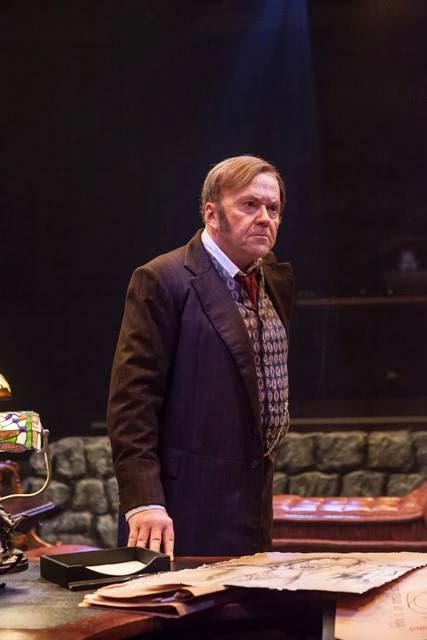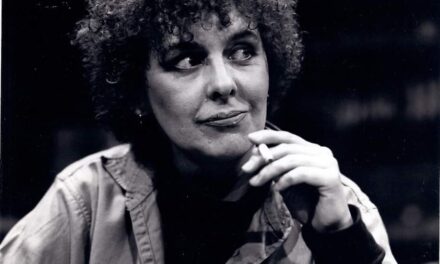FIDDLER ONCE AGAIN PROVES ITS STAYING POWER IN BROADWAY SERIES
Fiddler on the Roof
Music by Jerry Bock, Lyrics by Sheldon Harnick
Book by Joseph Stein
Directed by Sammy Dallas Bayes
A review by Kathi E.B. Ellis
Entire contents are copyright © 2012 Kathi E.B. Ellis. All rights reserved.
 |
|
John Preece leads the cast of Fiddler on the Roof.
|
Tuesday, January 17, saw the opening of the PNC Broadway in Louisville’s 2011-2012 season – an odd calendaring eventuality in itself as long-time impresario Brad Broecker acknowledged in his enthusiastically-received curtain speech. More than that, the season – filled with must-see titles (Mary Poppins, Billy Elliott) and the ever-intriguing Blue Man Group – is opening with that “Timeless Classic of American Musical Theatre” (per the program cover) Fiddler on the Roof. And therein are both the hook and the challenge. Since its 1964 stage debut and 1971 award-winning movie version, Fiddler has been produced at all levels of theatre.
This production is directed by Sammy Dallas Bayes, who has been associated with Fiddler on the Roof as performer (1964), choreographer (1990) and now director since the earliest days of the production. He also was designated by Jerome Robbins to maintain the original choreography for future productions of the show; and it’s this contribution to the show’s history that may be a key to the longevity of its success and consistency over time.
Audiences come because they love the music, the characters and the universal story of survival against all odds. Indeed, if audience members sitting within earshot on Tuesday night are typical, many of us know the lyrics word for word – if not always note for note. But, because audiences know and love Fiddler, we also bring strong preconceptions about what our experience should be.
For me, my experience on opening night was mixed.
I came to the theatre having seen the movie many times: the 1983 London revival with Topol, several stage versions at community and high school theatres, as well as the lackluster 2001 tour at the Louisville Palace. And I have a hand-carved “Anatevka” sign that still hangs in my home from a long-ago production in which I was involved.
My initial mixed reaction came with the show curtain, a perfectly innocuous forest vista. This conjured up a vague suggestion of Russian woods, in a color palette that spoke to early 20th century painting. A scenic convention of the period, this was then contradicted by the movable scenic pieces, with no traditional backdrop, once the show curtain flew up at the top of each act. An additional issue resulted from a far house left seat that enabled me to see not only the onstage action but also actors waiting for entrances and technicians upstage of Tevye’s house. An unfortunate bonus was also not being able to see the upstage right area of the stage – missing, for example, Fyedka (Michael Shultz) and Chava (Chelsey LeBel) in the ballet sequence.
As the familiar music and lyrics and iconic dance steps of tradition filled the Whitney stage and auditorium, I was faced with another conundrum. Here were men and women dancing together, holding hands, as they circled the stage. Yet later in the production Perchik (Joshua Phan-Gruber) breaks a serious social taboo when he teaches Hodel (Sarah Sesler) to dance, and then invites her to dance with him at the wedding; even when the Rabbi (Billy Holly) concedes that the “good book” doesn’t explicitly forbid dancing, he places a handkerchief in his hands, between his female partner and him, when he dances. The issue of how the genders interact in this traditional society is so significant to the turning points of the story that this opening image disturbed me…undermining as it does a central motif of the rest of the story.
Mr. Preece’s Tevye arguably carries the show. And he is at his best when he allows the music and text to carry his characterization. The scene between him and Hodel when she leaves home was one of the most poignant and powerful of the evening – two humans quietly grappling with an untenable situation for both of them. According to Mr. Preece’s program bio, he has performed this role close to 2,000 times over the spread of several decades. It’s clear he knows how to move the audience to tears and to laughs; he knows how to elicit the reliable laughter. But there are times when that choice interrupts the rhythm of the scene, when trusting that the laugh would happen, without a helping hand, would have been the stronger choice; for example, the final goodbye between Tevye and Lazar Wolf (David B.Springstead, Sr.).
The show is also arguably Tevye’s, but even a poor milkman needs appropriate support. Perchik’s passion for the potential new order was effectively drawn, as was the growing relationship between Hodel and him. Motel (Andrew Boza) was a delightful foil to Perchik, demonstrating how the quiet and persistent can find the strength of their convictions, albeit differently from those who are more outspoken. Hodel and Chava found a touching dignity in their life choices. The bottle dancers were energetically precise in this signature sequence of the show. Their long, black, formal coats flicked outwards, revealing surprisingly rich-colored linings, a contrast to the drabber daily costuming, signifying the importance of ritual in community traditions. Less successful was the sequence in the tavern with the Russian soldiers; their interruption of the celebration between Tevye and Lazar Wolf was vocally unremarkable, and the dance sequence did not rise to the level of precision of the previously noted sequence. I found the primary females to be a trifle strident. Golde (Gerri Weagraff) is a strong presence within her family, but I wasn’t moved by “Do You Love Me,” the one time when the text permits Golde a moment to let down her guard. Yente (Kristin Moore) was played primarily for laughs – and successfully so – but again, a choice that makes it more challenging to hear her desire to travel to Jerusalem. On opening night, Brooke Hill’s Tzeitel struggled with her higher register during “Matchmaker” and repeatedly demonstrated that, vocally, she was her mother’s daughter.
Even with tempos that at times felt a little pushed, for example “Sabbath Prayer” and “Far From the Home I Love,” Act One clocked in at around an hour and forty minutes, with the end of Act Two bringing the total production in as a three-hour experience – long by today’s audience attention spans. I was bemused by people leaving minutes before the end of the show. If you made it through two hours and fifty minutes, why not stay for the final number and the promise of new lands? The vast majority who stayed were enthusiastic in their response to the performance, giving Mr. Preece a standing ovation and the whole company sustained applause.
Once more, Fiddler on the Roof is proving its staying power. With themes of tradition and change, exclusion and solidarity, faith and love, almost everyone in any audience will find some moment with which they have a fundamental connection; and from that moment, the story grabs hold of us. After almost fifty years, that’s…nice to know…
Fiddler on the Roof
January 17-22, 2012
PNC Broadway in Louisville
The Kentucky Center
501 West Main Street
Louisville, KY 40202
502-584-7777
http://louisville.broadway.com/
The Kentucky Center
501 West Main Street
Louisville, KY 40202
502-584-7777
http://louisville.broadway.com/





situation at the Sleep-Tite Pajama factory are anything but passive, as sparks fly between new officer Sid Sorokin and Babe Williams, organizer of the union grievance board Click Here.